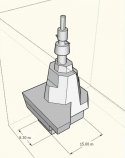The carrier mockup in Wuhan might be getting a new modification to its island.
The images below show an alleged procurement announcement on a renovation project to an existing structure. The renovated structure is 20 meters in length and 30 meters in height, with requisite windows, openings, doors, railings, etc.


Interesting.
This CGI comparison done a few years ago by 大包00 is somewhat speculative (particularly for 003 at the time and definitely for "004" which is just their own speculation), but it does compare the relative sizes of the other carrier islands reasonably.

If the length of the new island is 20m overall or 20m footprint deckspace, that would definitely lend itself more to a singular island size you'd expect for a CVN rather than a CV.
Also worth noting on the Wuhan mockup, as they adjusted the island between CV-16 design, to CV-17 design, to CV-18 design (progressively shorter/smaller), I don't think they actually cut down the structural footprint on the mockup itself in terms of footprint taken on the "deck" of the mockup. So if this tender is for a new island I wonder if they'll rebuild it from the "deck" up or if they'll just add another layer or shorten one of the upper layers while keep the base structure as it is.


